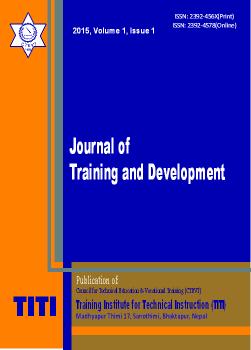Technical and Vocational Education and Training in Workforce Development
DOI:
https://doi.org/10.3126/jtd.v1i0.13094Keywords:
Technical education, vocational training, workforce, economic growthAbstract
There are many contributions of Technical and Vocational Education and Training (TVET) on a nation’s economy. TVET has been proved as the key for skill development. With its feature focused on specific occupation, it has allowed individuals to find skill related jobs or start own employment. TVET stands a major player in economic growth of a nation through development of workforce and rise in employment rate. On one hand, TVET’s role stands on employment generation in the job market while on the other hand, TVET is regarded more significant to promote self employment where employment opportunities are scare and individuals are enrolled in informal or agricultural sector. This paper tries to explore different contributions of TVET on employment in the labour market and in uplifting self employment through the development of relevant skills and the different kinds of contributions it gives and importance it holds depending upon the economic development of the nations.
DOI: http://dx.doi.org/10.3126/jtd.v1i0.13094
Journal of Training and Development Vol.1 2015: 77-84
Downloads
Downloads
Published
How to Cite
Issue
Section
License
Authors who publish with this journal agree to the following terms:
- Authors retain copyright and grant the journal right of first publication with the work simultaneously licensed under a Creative Commons Attribution License that allows others to share the work with an acknowledgement of the work's authorship and initial publication in this journal.
- Authors are able to enter into separate, additional contractual arrangements for the non-exclusive distribution of the journal's published version of the work (e.g., post it to an institutional repository or publish it in a book), with an acknowledgement of its initial publication in this journal.
- Authors are permitted and encouraged to post their work online (e.g., in institutional repositories or on their website) prior to and during the submission process, as it can lead to productive exchanges, as well as earlier and greater citation of published work (See The Effect of Open Access).




